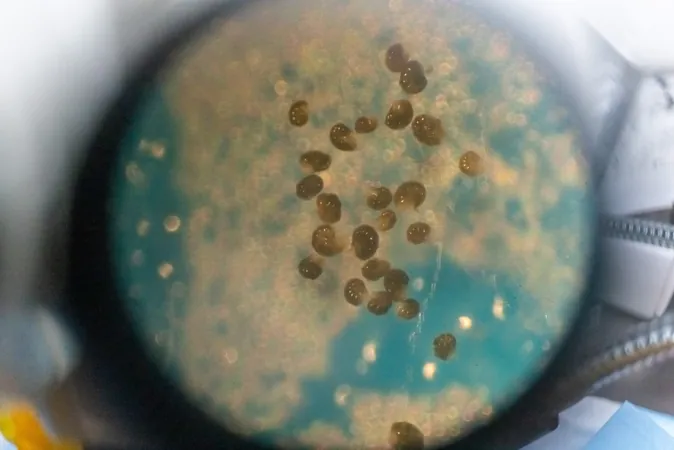
Unveiling the Secrets of Life in the Deep: How Foraminifera Flourish in Total Darkness
2025-01-17
Author: Nur
Introduction
Most life on our planet thrives under the warm embrace of sunlight, extracting energy through photosynthesis. But what about the tenacious microorganisms that dwell in the pitch-black and oxygen-free depths of our oceans? A groundbreaking study spearheaded by the Woods Hole Oceanographic Institution (WHOI) and featured in The ISME Journal offers intriguing insights into the survival of a remarkable species of foraminifera—tiny, single-celled organisms that exist in some of the Earth’s most extreme environments.
Chemoautotrophy and Foraminifera
At the heart of this study is the process known as chemoautotrophy. This metabolic marvel allows foraminifera to harness energy from inorganic compounds—possibly sulfide—enabling them to thrive where others cannot. While chemoautotrophy has long been documented in Bacteria and Archaea, the significant revelation here is that these foraminifera—being eukaryotes—possess a defined nucleus, setting them apart from their simpler microbial relatives.
Environmental Insights
According to Fatma Gomaa, a research associate at WHOI's Geology & Geophysics Department, the environment these foraminifera occupy bears striking resemblance to Earth's conditions during the Precambrian era—an age so ancient that it predates the advent of complex animal life. "Back then, the oceans were mostly devoid of oxygen and teeming with toxic inorganic compounds, much like some regions of today’s ocean floors," she explains. This discovery not only sheds light on their adaptative strategies but also enhances our understanding of eukaryotic evolution.
Research Methodology
The research team undertook expeditions utilizing the remotely operated vehicle Hercules from the E/V Nautilus to gather sediment samples approximately 570 meters below the Pacific Ocean surface, just off California’s coastline. They adopted two primary methodologies to dissect the foraminifera's life strategies. One approach involved infusing samples with a preservative identifiable by a red dye, allowing researchers to analyze live specimens in situ. The second employed isotopic carbon tracers to monitor the movement of metabolites, offering critical data on the organisms' carbon sources.
Key Findings
“Analyzing these seafloor tracer incubations revealed that the carbon moved through the water and was associated with foraminifera biomass, pinpointing how these organisms procure their sustenance,” commented Daniel Rogers, an associate professor of chemistry at Stonehill College. He emphasized the importance of conducting these observations at depth to prevent the alteration of the organisms’ natural behaviors due to environmental changes on the surface.
Resilience of Foraminifera
Joan Bernhard, a senior scientist at WHOI and a seasoned expert on foraminifera, noted that these organisms are astonishingly prevalent, with dense populations in even the harshest conditions. "In a volume comparable to a pencil eraser, you could find around 500 of these species, thriving in their dark, sulfidic environments," she remarked, highlighting their resilience.
Extraterrestrial Implications
Interestingly, this research garnered interest from NASA, as scientists are eager to explore life's potential in extraterrestrial locales. The parallels between the deep sea and these distant worlds—characterized by frigid temperatures, darkness, and often, an absence of oxygen—raise fascinating possibilities about the universality of life.
Kleptoplasty
A particularly intriguing aspect of this study is the behavior of these foraminifera regarding kleptoplasty—the ability to assimilate chloroplasts from other organisms, which can perform photosynthesis under sunlight. Despite their residence in total darkness, these foraminifera seem to thrive by utilizing chloroplasts in innovative ways, prompting inquiries about their success in such extreme conditions.
Climate Change Studies
In addition to their striking survival mechanisms, foraminifera play a significant role in climate change studies and the search for hydrocarbon reserves. With fossil records extending back over 500 million years, they offer vital clues regarding Earth’s climatic history. “By investigating the geochemistry of foraminifera shells, we can unravel how they responded to shifts in environmental factors such as temperature and oxygen levels, ultimately refining our understanding of climate history,” Bernhard elaborated.
Conclusion
The findings of this study challenge our perceptions of ecological adaptability and underscore the potential for other, yet-to-be-discovered foraminifera species to survive in similar ways. As we draw connections between the deep sea and outer space, the knowledge we glean may reshape our understanding of life itself—both on Earth and beyond!
 Brasil (PT)
Brasil (PT)
 Canada (EN)
Canada (EN)
 Chile (ES)
Chile (ES)
 Česko (CS)
Česko (CS)
 대한민국 (KO)
대한민국 (KO)
 España (ES)
España (ES)
 France (FR)
France (FR)
 Hong Kong (EN)
Hong Kong (EN)
 Italia (IT)
Italia (IT)
 日本 (JA)
日本 (JA)
 Magyarország (HU)
Magyarország (HU)
 Norge (NO)
Norge (NO)
 Polska (PL)
Polska (PL)
 Schweiz (DE)
Schweiz (DE)
 Singapore (EN)
Singapore (EN)
 Sverige (SV)
Sverige (SV)
 Suomi (FI)
Suomi (FI)
 Türkiye (TR)
Türkiye (TR)
 الإمارات العربية المتحدة (AR)
الإمارات العربية المتحدة (AR)